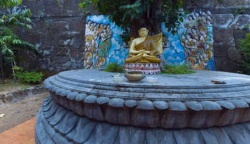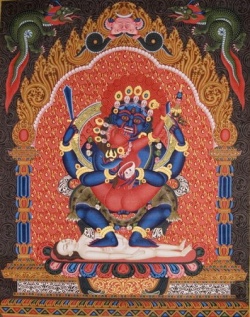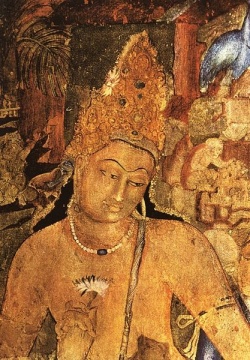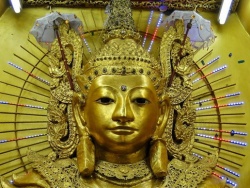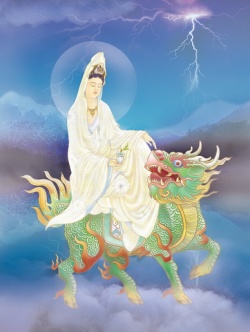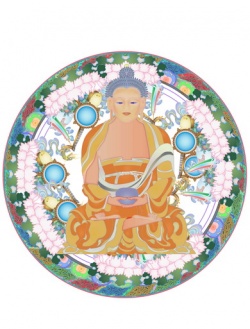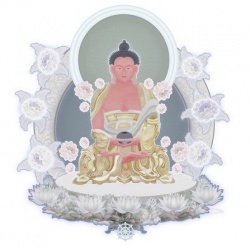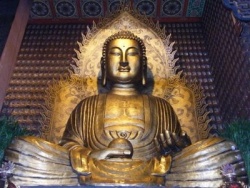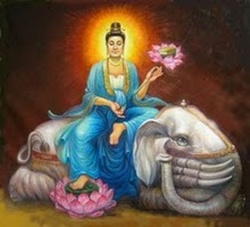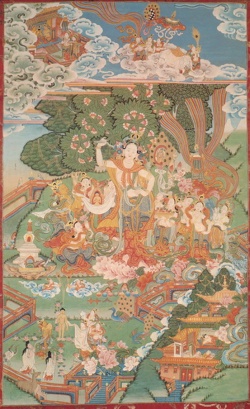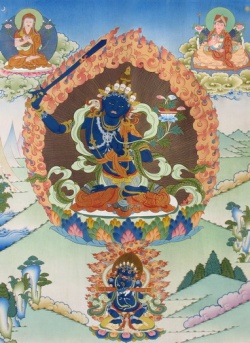The Buddhist Doctrine of Nibbāna
Venerable Dr. Parawahera Vajirañāṇa Thera
The Buddha has given to the world a profound Doctrine, unprecedented in the history of mankind. His was a universal and eternal rule of virtue and wisdom. His was the system flowing upward, the way out of this painful saṃsāra, one progressive adventure leading to the supreme goal of Nibbāna.
The world has inherited the teaching of the Sakyamuni as his unique contribution to the commonwealth of spiritual treasure, in which all the wills of his converted were gathered together into one multifarious activity of human civilization to save the history of mankind from being a dull and painful record of human folly and bloodshed. The real value of the Buddha’s teaching lies in his unique doctrine of Nibbāna, the most refulgent flower of the Aryan culture. Its teaching is irrefutable and self-evident. That life teems with suffering is its teaching. It is not a myth, but it is the fact. There is happiness also to be found, and it is within, not without. Find the cause of suffering and remove it. Happiness then will be the reward. The cause of suffering lies also within life itself, and it is egoism and craving that are responsible for the disturbed harmony of life, but not the anger of any invisible power, or a forbidden fruit, or Pandora’s casket.
According to this simple teaching all forms of craving must be extinguished to make life serene. The very idea of Nibbāna is the state of mind co-extensive with this serenity. Here surely we have the most complete analysis of the motive and meaning of the universe. The universe is not the issue of a cosmic giant hidden somewhere in the sky, nor is it of primordial germ like a cosmic egg. To admit a universal first principle is scientifically an impossibility as well as a philosophical absurdity.
To begin with, the craving for individuality is the cause of all turmoil and greed. The craving for life results in three possible manifestations which are all evil. First comes the craving for sensuousness, the desire to gratify the senses. The second is the desire to prolong the cycle of life. Third is the desire for personal immortality. All this means the worldliness which is the cause of all commotion and unrest. There can be no happiness, no righteousness, nor social order, if man is not free from selfish desire and egoism caused by this threefold craving. It is the way out of this craving and the attainment of eternal peace, that is taught by the Buddhist doctrine of Nibbāna as the Supreme God of all humanity.
To understand the full significance of the Buddhist Doctrine of Nibbāna it is necessary to have some knowledge of other systems of thought with regard to the final goal of life. The immortality of the soul as the final destiny of man is the most persistent idea in all other religions, and this belief appears earliest in its crudest beginnings in the savage mind of primitive man. From the time of primitive man, many people have believed in it, in some form or other, very earnestly and seriously. When the Buddha made his appearance in India, it was current not only there, but also in other parts of the world. Later, the great bulk of the human race, became so absolutely certain of the truth of their belief in the soul’s immortality that they did not dare to entertain any other thought however rational and scientific it might have been.
But to understand the objective validity or the futility of this belief, it will be useful to review the original ideas and the outstanding points in their development. There is a bewildering 3
variety of views on the belief in the soul’s immortality held by different schools, and the beliefs in (1) the life of the dead, (2) the resurrection of the body, (3) transmigration of the soul, and (4) the final return of the soul to its divine origin, are the most prominent among them. Animism: The conception of the life of the dead is probably the earliest thing to appear in religion, for it was the only religion of the early men, both of the East and West, before they had come to believe in gods. It is as old as that early savage level of thought in which no distinction was made between the animate and inanimate and the ideas of life and death themselves were but very ill demarcated. With the rise of crude hylozoism, the oldest primitive conception of the all-pervading life of matter, a vague adumbration of the existence of a soul began to pervade humanity:
“All matter is alive, and all living beings have souls. Nothing perishes which has once existed, and things which appear destroyed only change their natures and pass into another form,” is a simple statement of this belief.
The earliest Egyptian as well as Indian records attest this belief, and it is only an appropriation from the primitive men who used to derive their hypothesis mainly from the generic images of impressive phenomena.
The concurrent suggestions of such phenomena as sleep, dreams, insanity and death would easily induce the primitive mind to believe that there is something in the bodies of the living, something that is an impalpable counterpart of the body, a distinct entity which could go away from the body at will and return to it again. For the savage mind, proof of this would lie in the fact that it is this inert body or soul of the sleeper that awakes him to report dream adventures in some remote regions where he seemed to have been hunting or fighting, making love or feasting, meeting or consorting with people already dead.
This soul or life of the body was regarded as something bound up with the breath, which at death finally departed from the body to live independently as a ghost in an ethereal state. In point of fact, it is this primitive conception of the independent existence of a soul that has given birth to the idea of immortality.
During those early stages of primitive speculation the dead were regarded as bodily living. A dead person is the one whose soul or breath has left him, as if it were to roam about freely, but may return again to the body when it wants to be fed or tended. At this stage men kept the corpses of their dead relatives at home or in caves until they decayed, and this probably gave rise to the custom of mummifying dead bodies as was practised among the Egyptians as well as among some savage tribes.
This simple, presupposed faith in survival after death, shown by the care taken by primitive man towards his dead, thus waxed into a definite belief in human immortality. In this first stage of its development immortality is conceived as the existence of the soul in an ethereal from more or less invisible. This belief was probably held by some Egyptians, Greek and Romans, and later by most of the Jews, as it was believed by pre-Buddhist Indians. It was simply a continuation of life under conditions more or less favourable, a creed appropriate to the animistic cult. Brahmanism: In the second stage of thought the fear of the dead became more obviously apparent in the savage mind; men dreaded the return of the ghost or the moving corpse, and strove to keep it away from the sight of the living. Burial was introduced as a simple mode of disposing of the remains of the dead, and from the practise of the funeral rites arose the idea of Resurrection. Men did not forget their dead and buried relatives, especially when they were in need, and thought that the dead would rise from their graves incarnated with a fresh body and life. In the Vedic funeral hymns we find the idea of reincarnation or resurrection of the dead coming to hold a definite position in Indian belief.
The son or a close relative of the departed 4
(preta) is instructed to make periodical offerings at the grave and invoke the deities supposed to be guardians and rulers of the dead; and the dead person is thus addressed: “Go forth, go forth, along the paths where fathers
Of ours before have travelled on aforetime;
Both kings exulting in their own oblations
God Varuna shall you behold and Yama.”
“Come with the fathers, come along with Yama,
With gifts and offerings in the highest heaven;
Come home again, leaving behind all evil,
Come with your body, full of life and vigour.”1
The resurrection which appears at first as a revival of the dead in bodily existence is afterwards regarded in Semitic religions as the last stage of the world a redemptive purpose of God. It assumes the moral distinction of the righteous and the wicked in a vague administration of divine judgment. Its deepest motive, however, is religious. A blissful heaven is promised for the pious, as a reward for the good, and the lot of the ungodly is decided in a hell as the punishment for misconduct. Its tenets are included in “(i) the manifestation of God; (ii) the universal judgment; (iii) the perfect kingdom of Heaven coming after the judgment; (iv) the resurrection of the righteous to the everlasting bliss in the presence of God; (v) the damnation of the wicked to eternal shame and misery.” In this doctrine of resurrection we find a belief in the immortality of both happiness and misery, and it is one of the most remarkable curiosities in the history of religion that such an idea has been developed into a definite doctrine of the final condition of man and the world.
Transmigration: As a modification of this entirely mythical idea of individual immortality, there arose in the third stage of development the belief in the transmigration of souls. It has come as a solace to those who were in despair about the unfair judgment passed on the wicked souls, and sought for a fair justice according to the merits of their crimes. The belief in transmigration was always extensively held in many different parts of the world. 2 According to this belief the judgment of the soul was conducted by some powerful gods assisted by minor deities, by assessors, supposed to represent each of the various crimes from which the dead person was expected to be free. In Egypt it was conducted by Osiris, and in India by Yama, the king of the dead. The general belief was that the souls of men are emanations from the Divine Soul, and each is supposed to return to its divine origin when it is accepted as sufficiently pure at the judgment. But those found guilty of sin are doomed to pass through a series of lower bodies in order to become sufficiently purified. The Egyptians thought that the sinful souls would be purified by a lengthened sojourn in the bodies of unclean animals such as the hippopotamus, crocodile, pig or serpent. Pythagoras, who introduced the doctrine of transmigration to Greece, thought that the soul assumes the form of bird, like that of a wild fowl or a wood-cock, the idea which Shakespeare has ironically ridiculed.
The special characteristic feature of Indian belief in this doctrine is that the soul transmigrates from one mode of life to another, and the physical condition of each is determined by the moral and religious life of the preceding. Here we find the Indian doctrine of Karma coming to the field to form the various schools of ontological and eschatological thought which held the 1 Bṛhadāraṇyaka Upaniṣad, 1–4–14; 4–4–5, trans. by E. J. Thomas. 2 See The Case for Rebirth, The Wheel no. 12/13.
Indian population in a net of views3 for centuries. Karma was originally a mythical conception attributed to Varuna, lord of the physical and moral order of the Universe. When mythical conceptions entered into the Vedic pantheon, the early Indian mind was completely emancipated from connections with natural phenomena, whereby the cosmic changes were formerly explained, and new tendencies began to develop. The Universe was introduced as a sacrifice performed by Varuna, the lord of ṛta. Ṛta refers to the law of the Universe, the order of sacrifice and the moral law of the world. On account of ṛta everything in the Universe has a prescribed course; the sun and the moon pursue their course day and night respectively across the sky; the seasons move regularly in light and shadow across the earth; each individual performs his duties according to his own caste. The Karma is the duty, and it is the ritual of sacrifice.4 The welfare of human beings depends on the sacrifice to deities. Thus developed the belief in Sacrificial Karma, and belief in gods. The gods were personal beings who were responsible for everything beyond human control.
The happiness of man was to be attained through divine mercy, which could be won by placating deities with offerings that serve them as food. This may have a connection with the idea that food (annaṃ) is the vital element by which everything is sustained. To gain the desired happiness the sacrifice had to be performed according to the injunction of Prajāpati, the lord of the Universe, and it was to be conducted by the Brahmins who were supposed to be holy men born from the mouth of Brahma. When the idea of the moral law entered into Karma, the knowledge of God was essential for the moral life of the individual. When moral striving ends in religious practise the individual is said to be freed from all bonds of earthly existence, and to have attained immortality in a blissful heaven. But those who have not reached the highest perfection in knowledge and Karma will have other chances for perfection in the course of transmigration or saṃsāra.
Thus in Vedic Brahmanism the sacrifice is considered as Karma, as the binding principle (yoga). When it is performed for worldly gain it becomes the bondage to the sensuous existence in saṃsāra or transmigration. And when it is performed with the knowledge of God without selfish ego, it tends to release (mokṣa). Jainism: When the mythical conceptions proved wearisome to the intellect and men were harassed by doubts about God and sacrifice, Karma together with the theory of knowledge and the belief in transmigration, took a new turn to evolve a definite system of thought called Jainism. This godless (anisvara) system, like the scepticism of the Sophists, assumes that all truth is relative to the observer; there is no objective truth. Knowledge is only personal belief; everything is equally false. Every statement of a thing gives us only a Syat or ’may-be’ we cannot affirm or deny anything. But this system of scepticism has a great significance for the doctrine of transmigration of the soul. It draws attention to the physical elements of knowledge and karma, and gives an interpretation of the problem of the universe by its seven principles of analysis (saptabhaṅgi), which are as follows:
1. All substances (dravya) are divided into two:
2. lifeless matter or body (sarīra), and
3. soul or life (jīva).
Dravya is again divided into:
4. space (ākāsa), and two subtle substances
3 Micchādiṭṭhi; false assumptions.
4 Thus the concept of Karma in the Bhagavad Gīta differs from the Karma (kamma) of Buddhism, which is an ethical concept.
6
5. dharma or sukha, happiness; and
6. adharma or dukkha, unhappiness, and
7. pudgala, living matter.
Ākāsa, dharma and adharma are the necessary conditions for the souls and material aggregations which are the substance of all other things.
Ākāsa, space, gives them room to exist; dharma sets them in motion; and adharma makes rest possible to them. Matter assumes forms eternal and imperishable. It exists in two forms of atoms (aṇu or sūkṣma) and aggregates (skandha). Atoms change and develop, and assume forms in aggregation as earth, water, fire and air. The individual existence is evolved from these elements bound up with karma, and transmigrates in the process of evolution and devolution, atomic aggregation and disintegration, until karma becomes nullified.
Just as the Ionian school of Greek philosophy, Jainism asserts a material substance as the universal first principle from which the infinite multiplicity of phenomena has been evolved. In addition to the animistic conception that all matter is alive and all living things have a soul, Jainism has its own doctrine of Karma to replace the idea of a divine intelligence conceived in Greek philosophy as the harmony which constitutes the law of the universe. Karma in Jainism is recognised as quasi-substance ready to be transformed into the different degrees of individual action.
This kind of subtle matter fills all space, and pours into the mundane soul. Combining chemically with the soul it forms a subtle body which determines the fate of the individual. Karma leaves the mark of every change on the individual organism. Fresh karma always replaces that eliminated, and serves as the foundation of future existence. The soul must enter a new body until all karma is neutralised by the practise of austerities (tapas) and Yoga. The soul, though a substance, is not matter, but it is co-extensive with the body. It is characterised by intelligence (cetanā), which is indestructible and can never be annihilated. When every karma is purged off from the soul, it attains liberation (mokṣa) and ascends to the abode of the liberated souls on the top of the universe. Jainism thus believes in the transmigration of the soul as a necessary sequence to the law of karma which is entirely physical and independent of any divine authority, and in the separation of the soul from its material connection as the attainment of immortality.
Sāṅkhya: As an antithesis between the pantheistic theology of the Vedic Brahmins and the animistic pluralism of the Jains there developed an even more advanced system of philosophy called Sāṅkhya, expounded by a sage named Kapila. It is probably the oldest system of advanced thought and it explains cosmic change on the basis of mathematical relations. It systematically enumerates twenty-five principles (tatvas) of phenomena, consisting of twentyfour material and an independent immaterial principle. It views the undeveloped and the developed state of one and the same substance as the cause of the universe, and also believes in an infinite plurality of individual souls independent of the idea of a world-soul or an intelligent creator.
Its dualism is that there is the eternal co-existence of a material first cause which is called prakṛti (nature), undifferentiated originant, and the puruṣa, the permanent ātman or soul, which continually interact on one another. When the constituent factors of prakṛti are not in a state of equipoise (sāmyāvasthā) it becomes developed, in a gradual process of evolution, into all forms of the phenomenal universe, under the influence of puruṣa, the soul which stands behind, passive and unmoved. Prakṛti has three constituents (guṇa) in perfect equilibrium, which appear in matter as lightness, movement and heaviness, and are cited, in mental phenomena as sattva, 7
goodness or potential energy, rajas, passion or activity; and tamas, dullness or rigidity. Mahāt, the great, or buddhi, intelligence, is the first evolute of prakṛti. Ahaṃkāra, the egoity, consciousness or the principle of individuation comes next. From egoity, in its sattva aspect, arise the manas or the inner sense, the ten indriyas, the five sense organs and the five organs of action, hands, feet, speech, excretory organs, organ of generation: from them in the tamas aspect the five tanmātras, subtle elements (smell, flavour, form, touch and sound) arise. From these evolve the five mahābhūta, the gross elements (earth, water, fire, air and space). The souls, being connected with matter, become invested with a subtle body (sūkṣma sarīra) consisting of eighteen principles, namely, intelligence, consciousness, five subtle matters, and the organs of sense and action including the mind.
The soul, characterised by purity and intelligence, accompanies its subtle frame through the circle of transmigration, connecting itself ever anew with matter as the fruition of dullness, tamas or non-discrimination. It is only by cutting off its bondage of worldly existence by attaining perfect knowledge of the absolute distinction between itself and the other twenty-four tatvas that the puruṣa is liberated from the miseries of transmigration and continues to exist in eternal separation from matter. Sāṅkhya’s method of gaining this knowledge of salvation was Yoga, the mental discipline to suppress the observing activities of mind, conscious or unconscious. According to the Sāṅkhya’s theory of evolution, prakṛti, which is unconscious, itself evolves into all forms of phenomenal consciousness under the influence of puruṣa, the pure intelligence, the ultimate basis of all things.
No cause is given for the origin of prakṛti or puruṣa. But the free spirit (puruṣa) entering into the bonds of ignorance in the process of mechanical evolution of nature, experiences the miseries of transmigration. Freedom is the result of Yoga; and it is regarded as the path to the nirguṇa-ātman, the Self, devoid of constituent qualities. Yoga is the twenty-sixth principle thus added to the system. It is the path of the supreme God (isvara-pada) to the theistic Sāṅkhyas, and has developed a complete system of mortification of the senses by means of austerity. Vedānta: Those who were not satisfied with these theories followed the old teachings of the Upanishads, and believed that this universe is māya, illusory, god without substance. But it is governed by an invisible agency called “Brahman,” and that omnipresence is all-pervading and the knowledge of it is the path of salvation—the union with that supreme principle through yoga is nirvāna.
This doctrine of pantheistic conception has developed into Vedānta, a system of non-dualism (advaita), and it believes in Brahman as the sole reality, and the universe emanated by that supreme principle as non-real, māyā. The individual soul is different from its divine origin. Its divine nature is obscured by being entangled under the influence of māyā in the external adjuncts (upadhi) of the senses and vital air (breath). These, together with Karma, the law of action, accompany the soul in its transmigration. When the insight into Brahman is attained, the delusive veil of ignorance is removed, and the truth that the soul is divine and has always been with Brahman is revealed. The realisation of this unity through Yoga results in Mokṣa or Liberation.
Materialism: There is one more system worth mentioning. It is the materialism called lokāyata, which is confined to the physical law of the world. It holds that only this world is real, and denies all theories of spiritual substance and future existence. The soul is identified with the body, or the sense or breath or thought formed by the elements, earth, fire, water and air. When the body is destroyed, the soul disappears.
The world is born of itself from the elements. God is a myth; virtue and vice are conventional; pain and pleasure are the natural facts of life. Those who followed this system were extreme 8
materialists and believed in no religion. “All life, from the noblest human beings to the primordial animated germ is the result of the inter-action of material atoms, is governed by certain measurable physical forces. All yearning of man for immortality is futile.” They had no reason to believe that there is anything beyond the visible universe, and in consequence they decline entering into any argument upon the subject. Their idea of Nirvāna was a sensuous enjoyment to the heart’s satisfaction. So they were called “Cārvāka” or sensuous gluttons. This is a brief survey of some Indian systems of thought which indicate the main ideas of the soul’s immortality and the final goal of man. These systems have given rise to a variety of pre- Buddhist conceptions, and when Buddhism was advancing as a new revelation of thought, the mental life of India was one of mental intricacy, an entanglement within and without twisted together, as it were, in a net of views.
The whole power of human reasoning was displaying a new boldness to solve the ultimate problems of life and the universe. There were six famous philosophers by the names Pūraṇa Kassapa, Makkhali Gosāla, Ajita Kesakambala, Pakudha Kaccāna, Nigaṇṭha Nātaputta and Sañjaya Bellaṭṭhiputta, all of whom lived in Magadha in Buddha’s time. Apart from them there were Sāṅkhyas and many orthodox Brahmins.
Regarding the soul and its immortality, all possible hypotheses were taught by them. Sixtytwo views are enumerated in the Buddha’s discourse on views called Brahmajāla, the Net of Views. Their details are confusing, and the following is just an abstract to show their fantastic implications. They all fall into ten groups:
8. Four views on the eternity of the individual soul and the external world were held to assert that both the soul and the world as a whole are eternal.
9. Four views were entertained to say that the soul and the universe are in some respects eternal and in some not. They assert that God is immortal, but not individual souls. 10. Some held that the universe is finite, or infinite, or finite and infinite, or neither finite nor infinite.
11. Some entangled themselves in four ways in endless and equivocal arguments, wriggling like eels, refusing to accept any one doctrine, negative or positive. 12. Some asserted in two ways that the universe and the soul sprang up from nothing, and denied all possibility of any cause.
These eighteen views are held concerning the beginning of the world and belong to pubbanta, to the past. They all concern points of ontology.
The following are the eschatological views held in forty-four ways about the future of the soul and the universe, and they belong to aparanta, the future: 13. They (like early Vedic theologians) held sixteen phases of hypothesis of a conscious existence of the human soul after death.
14. To others the soul was unconscious in eight ways.
15. Some (like the Sāṅkhyas) held in eight ways that the soul is neither conscious nor nonconscious after death.
16. Others (like Pakudha Kaccāna) held in seven ways the annihilation of the soul after death, saying that it is dissolved into seven permanent uncreated substances (earth, water, fire, air, happiness, pain and life).
17. Some (like the Cārvākas or materialists) held that souls attain the bliss of Nirvāna in the present life in five ways: either in the full enjoyment of the pleasure of sense or in one of the four jhānic trances.
It is based on one or other of these views that almost all forms of religion and philosophy have come to exist, and all of them have their origin in the speculative thought of primitive men. As the means of the soul’s salvation people engaged themselves in various religious practises, some killing animals and even human beings, by way of sacrifice to their various gods, and praying them to grant them immortal happiness; some seeing the futility and wickedness of those practises, left their home-life and became wandering ascetics, and some were musing under trees and in caves.
Others, naked, sleepless and exposing themselves to cold and heat, tortured themselves as the punishment for their previous bad karma, or tried to burn out their passions by sitting in the midday sun with fires all round them. Some, in relation to the idea that water is the first element of the universe as conceived by the Upanishads, and also by Thales of the Ionian school, thought that it is the purifying element, and used to go to holy rivers daily to cleanse themselves of their sins. Others worshipped the sun and thought that the world where the sun resides is immortal. Some worshipped fire with the idea that it was the primordial principle. It was their belief that out of fire all things have emerged and into it all must return. When the Buddha appeared in the sixth century BCE, the world was teeming with such fantastic thoughts and beliefs.
The sixth century BCE was the most remarkable in all history. Everywhere there was an intellectual and religious awakening, and men’s reasoning was being displayed in a new field of thought. It was about the same time that Western civilization, inaugurated by the teaching of the Ionian school and Heraclitus, was giving a new turn to the early Greek thought by introducing his principle of universal flux that explained everything in terms of force, movement and dynamic energy.
It was at the same time that Jeremiah was giving a new message among the Jews in Babylon, and Confucius was animating the national life of China by his teaching of social ethics. In the Enlightenment of the Buddha, the world of the sixth century BCE was given a new vision, a new evaluation of life, a final solution of the riddle of the universe. His facts were simple, yet fundamental. He saw that there is suffering in life. What is the cause? Taṇhā or craving, egoism and ignorance. It is found within life. If this is so, surely there must be an escape, and it should be sought.
But it cannot be gained by killing animals and burning them in the name of a sky God. Nor did the Buddha think it is possible by asceticism and self-torture, to escape from life’s sufferings. Having discerned that life is bound up with suffering, he went forth, leaving his princely comforts for a greater and more worthy cause—namely, to find the way of escape. Seeking after the supreme happiness of release and making inquiries in others’ systems, he went from one teacher to another, then practised the most severe austerities until he became exhausted. Having realised the futility of those methods from personal experience, he took to the middle course, avoiding excess in either direction. He pursued the same path which he was practising as a Bodhisatta through immensities of time.
Meditation was his path, the analysis of that inexorable law of cause and effect. One day he attained Supreme Enlightenment with the realisation of the Truth of Saṃsāra, the wheel of birth and death. His mind was emancipated as the glorious consummation of his long course of practise, and experiencing the bliss of emancipation he breathed the solemn utterance: 10
“How sweet is the solitude of the peaceful, of him who has seen and perceived the Truth. Happy to be without malice and to be kind to all; Happy is the passion-free, Happy he who has no desire:
To have removed the notion ’I am’—that is the supreme bliss.” (Udāna.) Reflecting upon the profundity of his kamma and seeing the mental life of worldly people, he thought his doctrine could not be understood by them. For they were intent on worldly pleasure and their minds were so clouded with views and opinions that they would not give him a hearing.
But finding that there were some seeking the truth, whose minds could be easily purified from worldly taints and religious illusions, he proceeded to Benares to teach the Doctrine of Nibbāna to his first five disciples who were seeking after life’s release. There he proclaimed, declared and expounded the law of Dhamma and set turning the Wheel of Truth with the following words:
“Monks, one who has left the worldly life (for seeking Truth and happiness) should not follow these two extremes: indulgence of sense gratification on one hand and selfmortification in religious practise on the other. Avoiding these two extremes the Tathāgata has gained Enlightenment through the Middle Path, which tends to produce insight and knowledge tends to calm, to higher insight and to Enlightenment, to Nibbāna.” Then he explained the Four Noble Truths—the Truth of suffering, its origin, its cessation, and the path leading to the cessation of suffering—wherein the Doctrine of Nibbāna is embodied. At the end of his sermon Koṇḍañña, the head of the five disciples, attained the knowledge that “everything that is subject to becoming is also subject to cessation.” All the five disciples became Arahants in the course of instruction. Thereafter the Master, the Teacher of Nibbāna, continued to teach the Dhamma for forty-five years, and those who attained the happiness of Nibbāna during their lives testified to the efficacy of the system of the Master by such utterances as:
“Nibbāna have I realised,
and gazed into the mirror of the Dhamma,
the Noble Truth.
I am healed of my wound;
Down is my burden laid; My task is done;
My heart is utterly set free.” (Theragātha.)
Such, in brief, is the history of the doctrine of Nibbāna, taught by the Buddha, and it is flatly opposite to the idea of the soul’s immortality taught in all other religions. Now, let us see what Nibbāna really means. The Pali word Nibbāna is the name given to the supreme goal of Buddhism, and it must be understood in its Buddhist sense. It implies the peaceful state of emancipated mind of a person who has attained self-enlightenment, taking that state as his goal. It is to express this meaning that the Venerable Anuruddha has explained it in his Compendium of Philosophy in the following words (as translated by U Shwe Zan Aung): “Now, Nibbāna, which is reckoned as beyond these worlds5, is to be realised through the knowledge belonging to the Four Paths. It is the object of these Paths and their Fruits. It is called Nibbāna, in that it is a departure from that craving which is called ’vana,’ lusting.” This is to show that Nibbāna is not a thing that a mundane mind can comprehend.
It is a matter of understanding, not of dialectical ability, but of the inner illumination that comes of a spiritual 5 Lokuttara, transcending all saṃsāric states, including the heavens of form and formlessness. 11
growth which transcends the mind from its lowly condition of mundane existence to the supernatural wisdom. Here Nibbāna is shown as an object (ārammaṇa), but that is not an ordinary object perceptible to the senses. It is the object that is uppermost in the mind upon its entry into the Path of Transcendence. The Path-knowledge does not rise without that object, therefore, it is called the ārammaṇa of the Path consciousness. It should be noted that according to the laws of psychology if there is no such thing as Nibbāna, the Path-knowledge will not present itself. This suggests the possibility of Nibbāna, and it is an answer to those who say that the Buddhist idea of Nibbāna is a negative one. This object is the freedom from taṇhā (craving), which is the cause of saṃsāric existence. Hence it is ni-vana, departure from vana, lusting or craving.
Taṇhā is called vana in the sense that it operates (as if it were a thread or cord) to conjoin one life with another. Thus the Pali word Nibbāna is composed of ni + vana. Here ni is a negative particle meaning “absence,” and vana is a metaphorical expression of taṇhā. Nibbāna therefore means taṇhakkhaya, absence of craving or extinction of thirst. Translators have let Nibbāna be freely rendered by the Sanskrit term Nirvāṇa. The word was probably originally Buddhist. But it has now been associated with the pantheistic eschatology of Vedānta to express the absorption of soul into Brahma or the supreme principle, and this idea is radically opposed by Buddhism.
The Oxford Dictionary does a wrong to Buddhism when it defines Nirvana as “blowing out, extinction; in Buddhist theology, the extinction of individual existence and absorption into the supreme spirit as the Buddhist highest good, or the extinction of all desire and passion andattainment of perfect beatitude.” Here the Buddhist idea of Nibbāna is confused with the Vedāntic conception, which is essentially non-Buddhist.
Pali grammarians take nibbāna as composed of ni + va + na. Here the negative particle ni means “out.” The root Ö va is “to go” or “to blow,” and na is the suffix used to give an auxiliary sense; and the word is defined thus: “nibbāti-etenā’ti nibbānaṃ”—the aspirant goes out or becomes cool or extinct by the aid of this object. Hence it tends to the state of Release, and therefore it is called Nibbāna.
In reference to the essential meaning of Nibbāna the Venerable Sāriputta replied to the question of Jambukhādaka in the following words:
“Nibbāna, Nibbāna, they say. But what, friend, is this Nibbāna? Extinction of desires, extinction of hatred, extinction of delusion-that, friend, is called Nibbāna (S IV 251)”. There is the full meaning of extinction explained as “blowing out,” the blowing out of the fire of lust, hatred and illusion, and this Nibbāna consists of the Fruit of the Path, the actual attainment of the blowing out of the fire from the heart that was burning with it. “The world is aflame,” says the Buddha (S I 31), and according to the Commentator, it is aflame with the fire kindled by lust, hatred and delusion, and also by birth, decay and death, pain, lamentation, sorrow, grief and despair (A I 15).
Hence the saying: “aggi anāhāro nibbuto”—the fire having no more fuel is blown out (M I 487). “Nibbuto gini” fire is out (Sn 19), “sītibhūto’smi, nibbuto”—“Cool I have become, tranquil I am” (Theragātha 79).
These are the utterances of those who had attained Nibbāna during their life, and they have been the living examples to convey the meaning of Nibbāna in its full significance, the attribute of which is “santi”—peace, tranquillity or coolness. This is called Sopādisesa-nibbāna-dhātu—the 12
element of Nibbāna wherewith yet remains life’s substratum, and this refers to Arahatship. It is called sopādisesa6 because it is experienced in life.
Nibbāna as “asaṅkhata-dhātu,” the unformed element, is singular and has no limitation. Here Nibbāna is called a dhātu, an element. The word dhātu is the term used by the Buddha in opposition to the idea of soul-theory. Dhātu means “nissatta nijjīva”—“non-being, non-soul.” The Upanishads and the Jains use “jīva” in the sense of soul (ātman) as in “jīva-ātma, livingsoul.” “Tam jīvaṃ, tam sarīraṃ, what is soul, that is matter or body?” Using dhātu with Nibbāna the Buddha means that there is not even a purified soul in Nibbāna. It is also the complete denial of the idea of unity with Brahma or Isvara-Pada, Godhead, as held by the Yoga philosophy of mystics. Nibbāna is also called mamma to show it is no soul: “Sabbe dhammā anattā.”
Nibbāna is the bliss of emancipation which supersedes the complete annihilation of passions which are the bases of all the commotion and unrest of Saṃsāric existence. This is the visible fruit actually realised by the training in the Middle Path, avoiding all extremes in all directions. This path runs through the eight principles, viz, Right View, Right Intention, Right Speech, Right Action, Right Livelihood, Right Effort, Right Mindfulness and Right Concentration.
The disciple who treads this Path achieves moral purity in the first stage i.e., in the practise of the three principles: right speech, action and living, and thus he purifies his thoughts, words and deeds. Consequently he gains an unimpaired happiness of inward serenity (sīla-visuddhi). He then proceeds with the aid of right effort, mindfulness and concentration to meditate on a given subject of salutary nature and purifies his mind from lower tendencies, the five hindrances7 that impede the growth of knowledge. When he is free from sensuous passions, malice, sloth and torpor, distraction and agitation, and also from perplexity, he is like a man absolved from a debt, or recovered from a long sickness or released from a prison (cittavisuddhi). Being emancipated from these human weaknesses in each stage of the jhānas by the gradual waning away of mental defilements, he determines to develop right insight in accordance with right view and intention (diṭṭhi-visuddhi).
Discerning the three characteristics of phenomenal existence, impermanence, suffering and not-self, he develops full knowledge by the process of insight, in order to eradicate the roots of evil, the tendencies to attachment, hostility and delusion. Overcoming all doubts he is not puzzled by such quibbles as: “Am I? Am I not? What am I? How am I? From where have I come? Where shall I go?” (kaṅkhā-vitaraṇa-visuddhi).
On the way of his progress in pursuit of vipassanā, insight-knowledge, all the principles of enlightenment and all purifying elements become more and more intense. Then there arises in him a mental movement which raises the mind to the stage wherein he is assured of emancipation and is known as “culla sotāpanna,” a “junior stream-winner.” Proceeding further he experiences psychic illumination, higher knowledge, zest, serenity, bliss, resolve, exaltation, mindfulness, balance and desire to proceed further. Sometimes these super-normal psychic phenomena may deceive the meditator in regard to his attainment, and therefore they are called vipassanupakkilesa, impurities of vipassanā, or vipassanā fictions, whereby the aspirant may be under the impression that he is an Arahant, like the Elder Mahānāga. 6 Sa-upādisesa. Its correlate is Anupādisesa-nibbāna-dhātu, Nibbāna without personality-aggregates remaining.
7 Pañca nīvaraṇa; see The Wheel No. 26
Elder Mahānāga, who was living in Māgama, Ceylon, and attained these psychic powers, was deluded by the thought that he was an Arahant. Dhammadinna, his disciple, who was an Arahant, knowing his teacher was not yet an Arahant, went to him and asked a number of questions, which Mahānāga answered correctly. When Dhammadinna said: “Reverend Sir, your knowledge is very keen, when did you attain this Dhamma?” the reply was “Sixty years ago,”. “Could you practise your psychic powers?” asked Dhammadinna. “That is not difficult.” “Then create an elephant,” said Dhammadinna. Thereupon the Elder created a white elephant. “Now, Sir, make this elephant chase you with ears rigid, trunk thrust into the mouth, trumpeting furiously,” said Dhammadinna. The Thera did so, and seeing the terrible form of the created elephant approaching him, rose from his seat and took to flight. Dhammadinna caught him by his robe and asked: “Sir, is there such a thing as fear in one who is an Arahant?” The Thera, thereby knowing himself to he still a puthujjana, an ordinary person, said to Dhammadinna:
“Friend, be my preceptor,” and sat at his feet. “Sir, do not be anxious,” said Dhammadinna, and gave him a subject for meditation. Mahānāga practised it and immediately attained Arahantship. Such is the strange irony of spiritual pride: dhammuddhacca. The skilful aspirant will class these psychic powers with the other phenomena, as possessing the characteristic of impermanence, unsatisfactoriness, and not-self. Knowing them thus he realises that “this is the Path, and that is not the path” (maggāmagga-ñāṇa) The meditator then goes through a series of contemplations realising the rising and falling nature of phenomenal manifestations and their constant decay, and he understands them as being fearful and dangerous. Realising them as not-self he feels a disgust for them. Contemplating an escape from them he comes to the sign-post of his objective goal. There he gains the knowledge of adaptation (anuloma-ñāṇa). It is this adaptive knowledge that raises him from his worldly condition to a transcendental state, that is, to the Path to Nibbāna. This knowledge leading to emergence is also called “atammayatā,” “not made of that.”
It means that it is not made of taṇhā (craving), and does not depend on saṅkhāra, (saṃsāric elements). This knowledge cannot be found in any other system of thought. In the Saḷāyatana Sutta, (M III 220) the Buddha said: “Monks, depending on atammayatā, attending to atammayatā, you should reject, should transcend that indifference which has one state, which rests on one state.” This means that even when one attains arūpa-jhāna leading to the formless state of existence, one’s knowledge is not free from taṇhā because that jhāna is attained with vibhava-taṇhā (craving) “to be more, or to become more.” Hence it is called “tammaya,” made of taṇhā. It is depending on this knowledge that Ālāra and Uddaka did not realise any further attainment, and that is why the Buddha rejected them while he was mastering himself in their methods of seeking after Nibbāna. The arūpa-plane is a state of existence. Although it is free from physical matter, yet the mind exists there in a passive form. The Jains may have regarded this passive state of existence as immortal when they admitted that the souls, free from transmigration, ascend to the top of the world.
Now, the aspirant purifying his knowledge through nine stages of vipassanā, insight, (paṭipadā-ñāṇa-visuddhi) comes to the threshold of the Noble Path (gotrabhū) and leaving his mundane personality, enters into that of the Supramundane (ariya-bhūmi). There he comes to the first stage of ñāṇadassana-visuddhi, to the path of stream-winning (sotāpatti), and eliminating three of the ten fetters (self-view, doubts, and the belief in religious rites and ceremonies), sees Nibbāna for the first time as the visible fruit of his practise.
If he does not proceed further in the same lifetime, within seven births he will complete his course. When he does proceed further, he comes to the second path, that of Once-returning, Sakadāgāmi-magga; attenuating two more of the fetters, of sensuous passion and ill will, he sees 14
Nibbāna as the Fruit. If he does not make further effort, he will have one more birth in the plane of sensuous experience. Hence this Path is called Sakadāgāmi. In the third path, called Anāgāmi, Non-returning, with the complete elimination of sensuous desire and ill will he experiences Nibbāna as the fruit of the path. If then he does not reach the final attainment, Arahantship, in his present life, he is said to be reborn in one of the four Pure Abodes, Suddhāvāsa of the Brahmā-world, when he does not return to the plane of the senses, but in due time attains Parinibbāna, final release, on passing away from Suddhāvāsa.
The aspirant applies himself to the complete elimination of the remaining, five fetters, attachment to life in the material and the immaterial realms, pride, restlessness and delusion. In the next movement he becomes an Arahant, a Worthy and Perfect One, who is free from all impurities, released from the burden, one who has attained the final deliverance and won the Supreme Goal, the Bliss of Nibbāna.
This final emancipation, attained through the systematic development of the knowledge of the Four Noble Paths marks the culmination of the threefold training of virtue (sīla), concentration (samādhi) and wisdom (paññā); and it is the consummation of the extensive course of holy life expounded by the Buddha in the Middle Path, as the means of self-enlightenment, the only way to the supreme destiny of man.
This Nibbāna is called kilesa-parinibbāna, the extinction of impure dhammas, and it is Saupādisesa, Nibbāna experienced in life. The Arahant during his life experiences the Bliss of Nibbāna with perception and feeling while attending to his duties for the happiness of others, or he will be in the entire ecstasy of Nibbāna, nullifying feeling and perception in nirodhasamāpatti, complete cessation of his mental flow. When the Arahant dies his Nibbāna is anupadisesa, Nibbāna without life-substratum.
Thus Nibbāna is one as asaṅkhatadhātu, the Uncompounded Element: it is twofold as saupādisesa (or sopādisesa) and anupadisesa; threefold according to the three entrances (vimokkhamukha), that is, one of the three contemplations, anicca, dukkha, and anatta. It is fourfold in accordance with the four Paths. It is fivefold with reference to the elimination of the fivefold attachment to the five senses, and six-fold as it is attained by extinction of the sixfold craving pertaining to the six sense objects.
It is the question of what happens to the Arahant at death that has given rise to most discussion. At the death of an Arahant all his physical and mental aggregates cease together with all attributes relating to phenomenal existence. Hence the Arahant’s death is called khandha-parinibbāna, the extinction of aggregates in the asaṅkhatadhātu, the Unborn, Unformed, purified Element, and it is the release from saṅkhata, that which is born and formed. Referring to this, the Buddha said: “Monks, there is an unborn, unmade, unoriginated, and unformed. Were there not such a state there would be no escape from that which is born, made, originated and formed. Since, Monks, there is this state of the unborn … there is an escape from the born, made, originated and formed” (Udāna 80).
It was to find out and to proclaim this unborn state that the Bodhisatta endeavoured to attain enlightenment. “It is for the sake of attaining the unconditioned state of Nibbāna that the religious life in the Buddha Dhamma Is lived,” and this was the reply of that great Arahant Puṇṇa to the question of the Great Arahant Sāriputta, the Captain of the Faith, who questioned him about the purpose of living the holy life in the Buddha. The argument hinges upon such expression as “extinction” or “blown out as a lamp,” which are frequent in the Scriptures, as is seen in the following:
15
“The old craving exhausted, no fresh craving rises,
Freed from thought of future becoming
They like barren seeds do not spring again,
But are blown out just as a lamp.” (Sn 235)
A logically-minded critic may venture to ask whether the Arahant exists after death, whether he does not exist, or whether he is both in existence and non-existence. The Buddha has answered this kind of topsy-turvy argument by noble silence, knowing that it does not tend to any profit, but to more confusion.
There is neither an existent, nor non-existent object called Nibbāna, which we have to enter for the destruction of suffering, If there were a phenomenal object called Nibbāna then it must be subject to destruction, and none could have attained the eternal and immutable state. On the other hand, Nibbāna cannot be explained as being the annihilation of the individual and the world, for if we judge by the standard of ultimate truth (paramattha), we find that the self and the world are mere illusions in so far as they have no existence apart from our consciousness. Here, an idealist may conceive that there is something like that what Schopenhauer called “Will” or “Mastermind” standing between the self and the world. We should leave him to study the formula of nāma-rūpa, mind-and-matter, in the Buddha’s doctrine of paṭiccasamuppāda, the law of dependent origination. The idea of self (atta-diṭṭhi) and its connection with the world does not cease until ignorance (avijjā) ceases. The evil resulting from ignorance being withdrawn, the twelve links that constitute paṭiccasamuppāda, the chain of existence, are loosened. The fabric of the world and the self break-up, leaving only the infinite, the element uncreated and unformed.
This is the state of Nibbāna that the finite mind cannot grasp. The question is: “If the self and the world are mere illusions having no real existence, how is it possible to say that they undergo destruction?” Just as a man who has no head cannot be afflicted by a headache, so also the world and self which never had any independent existence cannot in any sense lose it. In fact, it is a mere contradiction in terms to say that the world and self undergo annihilation when it is asserted that they have no real existence, is not existence, and it cannot be non-existence. It lies totally beyond both existence and non-existence. Existence and non-existence are both conditional and relative to each other. Nibbāna which is “Absolute” cannot be designated as being either existence or non-existence. Nibbāna which is incomprehensible and profound can only be realised by those who have attained it and have thus passed beyond both limitations, existence and non-existence. “But where does this Nibbāna exist?” was the question raised by King Milinda. The Venerable Nāgasena replied: “There is no place in the East, the West, the South, the North, above, below or beyond, where Nibbāna is situated.
“Yet there is Nibbāna for he who is pure in virtue and possesses right insight, realises it, whether he is in Greece, Alexandria, Kosala or China” (Mil 323–26). Just as the fire is not stored up in a particular place but rises when the necessary conditions are present, so Nibbāna is not said to exist in a particular place, but it is attained when and wherever the necessary qualities are fulfilled. Nibbāna therefore, is not a heavenly place like the Egyptian Amenti, i.e., the West, or the Greek Elysium, or the Hebrew Paradise, or the Christian Heaven, or the Vedic Svarga.
When the deity Rohitassa asked, “Where does the world’s end exist?” the Buddha said: “It is in this fathom-long body with consciousness that I declare the existence of the world, its origin, its cessation and the path leading to its cessation.” Thus Nibbāna does not exist as a locality in space; it is to be realised as that which transcends the world. 16
Let us turn to our friends of the Mahāyāna school to see what they think about this asaṅkhatadhātu. Nāgārjuna, who was supposed to be a saint and the founder of the Madhyāmika school explained Nibbāna as “sunyatā,” voidness. He condemned all the degrees of realism of the Sarvāstivādins and asserted the ’māyic’ nature of existence. He denied the existence of the self and the world, and proclaimed the essential oneness of Saṃsāra and Nibbāna. In the Visuddhimagga, Buddhaghosa Thera says: “The Third Truth, the cessation of suffering, i.e., Nibbāna, is void of attā, self or soul, but is full of the essence of durability, goodness, and its essential characteristic is santi, peace.” This shows how he has opposed the idea that Nibbāna and saṃsāra are one, for these characteristics are not to be found in saṃsāra.
The Sarvāstivādins, discriminating between saṃsāric manifestation and the essence of pure Dhammas or elements, assert that asaṅkhatadhātu, Nibbāna, is an entity but without consciousness or rebirth.
In the Theravāda Canon there are references which assert that Nibbāna is the consciousness liberated from all worldly objects and thoughts, as is stated in the Dīgha Nikāya: “nibbānaṃ- viññāṇaṃ anantaṃ sabbato pabhaṃ.” Nibbāna is the consciousness that has no sign perceptible to the senses and it is immeasurable, the purest and a state wherein all connection with the elements ceases, leaving no trace (asesaṃ uparujjhati). (D I 223). In the Trikāya Doctrine of Mahāyāna; which was systematised later by Aśvaghoṣa, Nibbāna is identified with the Buddha’s sambhoga-kāya, the “bliss-body” as distinct from the dharmakāya and nirmānakāya. That Doctrine teaches that each and all of us have three kāya, our individualities constituting the nirmānakāya, and that our existence as part of the universal whole is our dharmakāya, while the influence we exert on those around us is our sambhogakāya. Endless are these options. They are for an ardent student to study. When we have attained Nibbāna and have realised the truth for ourselves all the quibbles of human thoughts will be vanished once and for ever, as it is said:
“When in deep, silent hours of thought,
To the Truth the holy sage attains;
Then is he free from joy and pain,
From form and formless states alike.
Where water, earth, heat, air no footing find,
There burn no lighting stars, nor shines the sun,
The moon sheds not her radiant beams,
But the home of darkness is not there.” (Udāna)
It is this final emancipation and eternal Peace, unruffled by the illusion of phenomenal existence, that Nibbāna means to us Buddhists. The very word Nibbāna is sacred to us, it is our last aspiration at the end of all our good action. Nibbāna is not to be discussed, committing it to dead words, but to be realised for oneself by oneself. Words are but imperfect manifestations of the thoughts of mundane minds, and Nibbāna cannot be touched by them. Hence it is well said: “What is to be heard, what is to be said about a Dharma, a State of Supreme Bliss that has no letters of the alphabet!”
In conclusion let me quote from The Light of Asia of that illustrious poet, Sir Edwin Arnold:
“If any teach Nirvana is to cease,
Say unto such they lie.
If any teach Nirvana is to live,
Say unto them they err; not knowing this,
Nor what light shines beyond their broken lamps,
Nor lifeless, timeless, bliss.
Enter the path! There is no grief like hate!
No pains like passion, no deceit like sense!
Enter the path! far has he gone whose foot
Treads down one fond offence.
Enter the path! There spring the healing streams
Quenching all thirst! there bloom the immortal flowers,
Carpeting all the way with joy! There throng
Swiftest and sweetest hours.”
Author’s Note
There is only one Nibbāna (Skr.: Nirvāṇa) and it is the same for a Supreme Buddha, a Silent Buddha and an Arahat. It is the extinction of the fires of greed, ill will and delusion; the attainment of realisation-by-Insight which destroys craving and so brings rebirth in conditioned existence to an end.
But two aspects of Nibbāna are distinguished. The first is sa-upādisesa-nibbāna, the Nibbāna that is experienced in samādhi while the Arahat is still living. This establishes the state of unchanging mental equanimity and bliss that can come about only when all forms of craving have ceased and the anxieties, fears and hatreds engendered by desire no longer trouble the mind.
The second is anupadisesa-nibbāna or Parinibbāna, the final Nibbāna reached at the end of the Arahat’s life, from which no further process of contingent ’becoming’ can arise. It is the second of these which I have chiefly discussed in the following pages. —F. S.
Nibbāna
The ultimate goal of the Buddhist life is the attainment of Nibbāna, but many people do not feel certain as to what Nibbāna really is.
One view, for which there is no support whatever in Buddhist doctrine, is that it is eternal life. The opposite is that it is annihilation. There is more reason for holding the latter view, but nevertheless it conveys a false idea.
It is not surprising that there should be such misunderstandings, because, by what we are accustomed to call ’common sense’ reasoning, it must be either the one or the other. But it is precisely these two pitfalls that the Buddha took great care that we should avoid. That is why most of the references to Nibbāna are in negative terms. Wherever the Buddha used terms with a positive meaning, such as Amata, the deathless, and; Dhuva, the Permanent, to describe Nibbāna, he did so in a more or less metaphorical sense. As descriptions the words are true, but they must not be taken in exactly the same sense as that in which we ordinarily use them. Nibbāna is without death because it is without birth; it is permanent because it is not subject to time and conditionality.
In order to form an idea of what Nibbāna really means, we must first of all understand what is meant by the words ’life and ’living’; and that, to begin with, is not so easy as it may appear. We may have a ready-made definition, but find that it does not apply in all circumstances, or that it does not cover everything we mean. What exactly are the characteristics of a living being, and what is the nature of the characteristics themselves?
By ’living’ we normally mean being conscious, being aware of our own identity, of our surroundings and of events taking place around us. It is that which makes the difference between a living person and a dead body; the one is conscious, the other is not. This does not 19
mean that an unconscious person or thing is always dead; but a dead body is always unconscious. There are many ways of being alive yet not conscious, as in the case of plants, but that is not what we usually mean by living; it is little more than existing, as a lifeless object does. Life of this kind consists simply of organic growth and decay. To be exact, a living organism is any aggregation of cells that sustain themselves, grow and multiply, by drawing nourishment from their environment. But this, at its simplest, is merely vegetable existence. Usually, when we speak of ’life’ we think of it in terms of consciousness, the awareness of selfhood that may be ascribed even to an insect, but which is lacking in a plant. Thus we instinctively connect the idea of life with the experience of pleasure and pain. Sensations that emerge into consciousness are an inseparable part of our idea of living, and they contribute, also, to our sense of identity and separateness.
We may tell ourselves incessantly that all life is one; but so long as we have not experienced the liberation from a body that feels sensations which others do not feel, and a mind that thinks as others do not, we cannot experience the idea of oneness as a reality. It amounts to claiming a transcendent position with regard to the world, without having had a transcendental experience, on the mere basis of an intellectual attitude. At the beginning, the notion that one can attain realisation by repeating formulas is a charming one; but repeated collision with the brute facts of a life in which every being is distinct from all others makes the attitude difficult to hold. This is perhaps the commonest cause of disappointment to those who have not understood that Nibbāna is something for which we have to strive, and that if we only try to persuade ourselves that we have already reached it, we are leading ourselves up a spiritual cul-de-sac. When we say ’life,’ we mean in general the quality of being conscious and aware of what is going on. Having this kind of awareness means that the living being is also conscious of time, because events cannot occur without a time-sequence. For anything to happen there must be the past, before it happened; the time of its happening, which we may call the present, and the time after it happened, which is the future.
Thus we see that if life is consciousness, it must be consciousness of something that is existing or happening in time. It is only in contrast to being conscious of ’something’ that we can be conscious of ’nothing,’ so that the ’something,’ whatever it may be, is always present in consciousness, either in the past, present or future. Now, that ’something,’ when everything is brought down to a single fact, is change. The future does not exist until it becomes the present; then in the instant it becomes the past, and again does not exist, except in memory. Even our knowledge of the difference between one thing and another, as between trees and houses, comes from our awareness of a change in our consciousness when we turn our attention from one to the other. The differences between light and dark, heat and cold, are also based on change, the change that takes place in our sensations when light gives place to darkness, heat to cold. And so it is with everything we associate with life.
There is continual change going on in our bodies as well as in our minds. just as there is in the organic life of plants. Nothing ever remains the same for very long, but one state is continually moving into another in a ceaseless flow. So we see that change is one of the essential characteristics of life; without change, or impermanence, there is no life as we understand it. Death itself is only another kind of change, in which the body ceases to function and breaks down into its chemical elements, while the craving-force (bhava-taṇhā, the will to live) and the Karma of the past produce a new being from the mental life of the former one. Death and rebirth are both part of the process of incessant change.
This continual flux of transformations consists, really, of the perishing of the old and the arising of the new; it is not the changing of things, but rather an unbroken succession of events, 20
that constitutes anicca, the impermanence of saṃsāra. And whether it be the changing modes of our consciousness, or the unconscious changes going on in our bodies, it never finds any permanent point of rest. It seems to indicate a chronic state of dissatisfaction; the body and the mind both seem always to be wanting to become something other than what they are from moment to moment. It is like a journey to nowhere in particular. If the mind is satisfied at any point it cannot remain so for long.
When we are feeling extremely happy we should like that state of mind to remain with us forever, but we find that after a time the happiness passes and some other mental sensation takes its place. Everybody knows that we cannot cling to happiness; its fleeting nature has been a subject for poets to lament over ever since poets first began stringing words together. If we make a serious attempt to find out why this is, we come to see that it is due to that essential condition of life by which nothing can remain static for long; and also to another law which always accompanies the law of change, namely that we can experience one thing only by contrast with its opposite. We should never know what happiness was if we could not also experience misery.
And if we experienced happiness unchanging for an extremely long time, without anxieties or painful sensations of any kind, we should finally forget what unhappiness was like. Then our happiness would cease to exist because we should be taking that state for granted, and should no longer be aware that we were happy. So it is obvious that a living being can be happy only if it is also capable of being unhappy. Happiness and misery, like heat and cold, light and dark, are things that exist only by way of contrast, and the contrast is an indispensable part of this process we call living.
Now, most thoughtful people, especially those who are capable of feeling the pain and unhappiness of others in a sympathetic way, are agreed that on the average there is more suffering than happiness in life. The great mass of living beings in the world are experiencing a life that is, on the whole, more painful than pleasurable. They are sustained chiefly by the hope, which is another feature of life and an indispensable one, that their condition will improve and that they will be happy at some future time. But the element of change which they rely upon to bring them happiness is also bound to destroy that happiness after a time, even if at last it comes, as we have already noticed.
So, taking everything together, we see that life, which is perpetual change, is on the whole unsatisfactory. When we are happy we may feel that life is good, like Robert Browning with his nonsensical ’God’s in his heaven; all’s right with the world’; but when we are suffering either mental or physical pain we are inclined to take the view that ’life is not worth living.’ Our feeling about life is therefore entirely subjective unless we can get away from our personal feelings for a time and look at it in a target context.
Then, if we review our own total experience, and add it to what we can see of the total experience of other people, to say nothing of animals—which after all are living beings as well— we must admit that on the whole life is a very sorry business indeed. Not for nothing is it said that man lives by hope. And it has been observed often enough that in many instances the hope is better than the realisation. If we could be happy long enough to get thoroughly accustomed to it, we should no longer be happy. The heaven of delight would become a hell of boredom. In this connection we may recall that the early Christian Fathers held that the happiness of the blessed in Paradise would be greatly enhanced by the sight of the damned, eternally burning in the nether regions.
Their authority for this was the parable of Dives and Lazarus in Luke 16; 20– 31. It was before it had become fashionable to dismiss everything we do not like in ancient scriptures as being symbolic, and not to be taken literally; and in more recent times the good Fathers have been reproached with an excessive zeal for revenge. But they may also have had it 21
in mind that Lazarus, in the bosom of Abraham, would be in need of some distraction to relieve the appalling monotony of his eternal life. Heaven, they may have recognised, was woefully deficient in the element of contrast which man requires for a full appreciation of his happiness. Either he must suffer himself at times, to make his happiness known to him, or he must see someone else suffering. It is a condition imposed by his own nature. Eternal, unchanging bliss requires for its maintenance a state utterly unlike any that can be associated with ordinary human consciousness.
Consciousness, as we have been discussing it, includes sensations and perception, but personality to be complete needs another factor, that of willing. We are not only conscious of the outside world, but also feel an urge to act on it in some way, and this will to act comes from the desire to achieve some particular object. The manner in which we tend to act constitutes our character, and it is formed by habits of thinking and acting in the past. There is nothing stable or fixed about this part of human personality, either. It is merely a tendency. So we notice that the man whom we have labelled ’selfish’ because he is selfish in general, is not invariably so. Neither is the ’honest’ man invariably honest. Human character is as fluid as any other part of the life-process. A good man may act badly at times, while a bad man may be capable of some very good impulses; and often these conflicting trends are so mixed-up that it is impossible to decide what the predominant characteristics are. To labour this point may seem unnecessary, but it has an important bearing on our inquiry, because we are trying to find something in life that is not subject to change.
So far we have not found anything that does not alter. Looking at the overall picture of life we see that it has these features of impermanence or changeableness, by which it flows on from one state to another, and of unsatisfactoriness which can range from mild displeasure to acute misery. We see that there is nothing constant and abiding in it; therefore, there is no essence to which we can point and say ’This is my Self,’ because the personality changes at different stages from infancy to old age, and indeed from one moment to another. The only connection that can be found between one state of the personality (or consciousness) and another is the fact that each one is caused by the one that existed prior to it, and that there is a connecting link of memory between them.
There is also the general proneness to think and act as we have been accustomed to do in the past; and this, as we have seen, is no more than a tendency. It is a mistake to regard it as an unalterable part of oneself, or as the Self with a capital letter. Now it is just this that Buddhism means when it says that life has three characteristics: impermanence, liability to suffering and lack of “selfness.” And the striking truth becomes clear to us that every kind of life as we know it must have these same characteristics. If there were no change there would be no life. If there were no suffering there could be no happiness, and if there were a permanent self that never alters it would be equivalent to a state of no change— and therefore no life. In mathematical terms we may say that these three characteristics give us the co-ordinates which add up to what we understand by ’life.’ So eternal life, which could be nothing but eternal change, could never produce any lasting satisfaction. With continual birth and death following upon one another we already have ’eternal life,’ in fact, though not personal immortality. The question we should ask ourselves is: “Is it desirable?”
We may answer ’Yes’ or ’No’ according to our circumstances at the time. But whether the answer is yes or no, the fact that we have to face is that eternal life could not be in any conditions very much better than the life we are experiencing at present with its contrasts and alternations. If it were without these features it would not be ’life.’ 22
A state which is without change and contrasts must be in all respects different from anything we can imagine from our own experience. We have nothing with which to compare it and no framework of ideas to fit it into. For one thing, it would be timeless, because time exists only where there is change. It could also contain no distinctions, for the differences which make us conscious of ’myself’ and ’others’ could not exist without these conditions of contrast and transition. For the same reason space as we conceive it could not exist, either. Unless, of course, we can visualise a space of one dimension, or a non-dimensional space. In any case, it is clear that the world of ’things’ and of people simply could not come into being where there was no possibility of change. Therefore a personal immortality of eternal duration is out of the question. At the same time, we have already seen that the idea of ’nothing’ itself cannot exist without the opposite idea of ’something’ being present, if only as a possibility: If Nibbāna were nothingness, it would also be ’somethingness’ by implication. Every affirmation depends upon the existence of a negation which is its opposite.
Our whole difficulty in conceiving Nibbāna lies in the fact that our thinking is bounded by opposites of this kind. We imagine that since Nibbāna is not eternal life it must be eternal death —the annihilation of something. But death itself is only a part of the life-process, as we have seen; it is just one of the many different kinds of changes that are going on all the time, and which are inseparable from life. Eternal existence and eternal non-existence are opposites of the same kind as light and darkness, heat and cold; neither of them has any real or absolute meaning. They are concepts which depend upon one another: they are aspects of merely relative truth.
It is the same with ’beginning’ and ’ending.’ We know that there cannot be an ending of anything unless there has been a beginning. What is more difficult for us to grasp is that there, equally, cannot be a beginning unless there has also previously been an ending. Yet such is the fact. If we ask, “How did the life-process begin?” We can choose between two answers, both of equal truth. One is that it had no beginning; the other is that it has its beginning with every fresh moment of conscious existence. But try as we may, we cannot find any point at which life started from nothing, or was created out of nothing. If it was created at any stage, its creator must have been in existence before it, which leaves us still no nearer to finding the absolute beginning of life. It only pushes the inquiry further back, to no purpose. In this situation we have to fall back upon the second answer as being the more manageable one for our discussion. If life begins at every new moment of conscious experience we see that its beginnings are dependent upon its previous endings, and this agrees with our alreadyformed picture of life as a flowing process, a flux of ’becoming’ which never quite reaches the goal of ’being.’ This helps us considerably, because it opens up the possibility of the life-process coming to an end. In other words it means that there can be a point at which, after ending, it can be prevented from beginning again. And since life is propagated by desire, the way to accomplish this is to eradicate the mental impulse of craving.
So Nibbāna is the annihilation of craving, the extinction of the fires of greed, ill will and delusion. This, then, is cessation of the life-process, which is not the same as the annihilation of a being. Where there has never been any real being there cannot be annihilation; but where only a process is concerned we can quite properly speak of its cessation. This is not a mere verbal quibble, but a distinction which points to something of tremendous importance. With the attainment of Nibbāna, it is a process of change that comes to an end, and with its ending there cease to arise all the other things which we have seen to be a consequence of that process, including suffering and the illusion of personality. So the Nibbāna that is entered into at the last passing away of a Buddha or Arahat is a state absolutely devoid of all the features of 23
life as we have seen it to be. To try to describe it in terms of what we have experienced in our life of change and of opposites would give a false and misleading conception of it. It is outside all of these categories; or, alternatively, we may say that the categories have no basis for arising in it. If we choose to class all the categories of things, events and experiences of life as passing phases, and therefore unreal—or only temporarily and relatively real—then Nibbāna becomes the sole eternal (dhuva) reality, if they are considered negative, Nibbāna must be the only true positive.
To put the case in another way: Nibbāna is not just another opposite in all the categories of opposites that make up our thinking. It is itself the absolute opposite of those opposites, the state in which they cannot possibly arise.
Here it is pertinent to stop and consider two propositions have been put forward regarding Nibbāna. The first is that ’Nirvāna and saṃsāra (the round of birth and deaths) are one.’ To get this statement into perspective, it is necessary to distinguish between the experience of Nibbāna known to the Arahant while he is still living, and the Nibbāna after death. The first is called in Pali, sa-upādisesa-nibbāna: Nibbāna with all the components of individualised personality still present. The second is called anupadisesa-nibbāna: It is Nibbāna without any substratum of personality in the present, and without the possibility of its arising in the future. This is the Nibbāna in which present and future do not exist, since it is free from all conditionality.
It is clear, from the descriptions given of the lives of disciples subsequent to their attainment of Arahantship, that although they could induce the Nibbānic consciousness whenever they wished, they were not, in their ordinary state, exempt from the pains of the flesh. Only their minds remained unaffected. Physically, they suffered from sickness and injury, as all mortals must do. Even the Buddha himself endured much in this way, towards the end of his life. He told Ānanda that it was only when he withdrew his consciousness from the physical plane that he could obtain bodily ease.8
Sa-upādisesa-nibbāna, therefore, is only intermittent release from suffering: as a continual state of consciousness for a living being it would be incompatible with the maintenance of life. Remaining in it constantly, the physical organism would perish. Far from being one with saṃsāra, it is the state in which all saṃsāric experience is suspended, so long as the Arahant remains in it. If he intends to live out his course, he has to emerge from the contemplation of Nibbāna so that he can again function within the modes, and according to the laws, of conditionality.
The Nibbāna after death is the same as that which the Arahant is capable of experiencing in life, but it is the absolute and final withdrawal from saṃsāric conditions. It is in this sense that it becomes ’permanent.’ As the Buddha taught it, Nibbāna is desirable because it is the cessation of births and deaths, and all the suffering they entail.
One may live with the intellectual understanding that all existence is anicca, dukkha and anattā and one may reach the full interior experience of it while still living; but neither of these is equivalent to that Nibbāna which is the total release from conditioned existence and its necessary suffering. A Bodhisatta is able to continue the round of rebirths while he qualifies himself to become a Supreme Buddha, but only by stopping short of the attainment of Arahantship. He does not experience Nibbāna and saṃsāra as identical. To him, Nibbāna is certainty because he has confidence. But it is a certainty belonging to the future, not to his present condition and daily activities. It may indeed be said that saṃsāra contains the potentiality of Nibbāna; but potential states and actual ones should not be confused: Nibbāna in 8 Parinibbāna Sutta; Last Days of the Buddha; The Wheel No. 67/69. 24
its fullest sense means the complete extinction of craving, not in one form only, but in all its manifold guises; and where craving is extinguished, there can be no re-arising of saṃsāric existence. This is the whole point and essence of the Buddha’s doctrine. The second theory that has been advanced about Nibbāna—though never by instructed Asian Buddhists—is that it is in some way equivalent to God. Not, of course, to the personal God of Western tradition, but rather to something resembling the Paramātman or Nirguṇa Brahman of Vedānta. That is to say, an impersonal God devoid of attributes, but from whom (or rather, which) all things have emanated.
It is certain that this idea of God arose after the time of the Buddha.9 It was in fact a rather desperate expedient to preserve the idea of a Supreme Power on a higher level than the mythical Creator whom Buddhism had shown to be unnecessary. It is difficult to see why, if this is what the Buddha meant by Nibbāna, he did not say so, instead of leaving it to others. But actually, the authors of the Upanishads themselves did not say that Nibbāna was equivalent to the Nirguṇa Brahman. Their intention seems to have been only to free God from the limitations of personality which the Buddha had shown to be defects.
The chief objection to the theory is that, by definition, Nibbāna is the cessation of the world, whereas the Nirguṇa Brahman, at one remove, is still its origin and the cause of its perpetual recreation. Because of this, he, or it, is responsible for all the obvious evils of the world, just as much as for whatever is good. The will to create, itself, implies desire on the part of the Supreme Power, and desire for anything argues a state of imperfection. If the Nirguṇa Brahman were complete unity and bliss, as it is represented, the emanation of the universe from it could only be a step down from perfection to imperfection.
The idea that God created saṃsāra, with all its ills, as a plaything, from the emanations of his own divine essence, is inherently repulsive. Apart from these considerations, Nibbāna, as we have seen, is described as the state of ultimate peace and security from ill. But the supposed Supreme Self is eternally agitated, being perpetually engaged in the creation, absorption and recreation of the universe. In these circumstances there can be no release or unchanging peace for the individual self that becomes united with it. In this system of thought the term mokṣa is used, rather than Nibbāna: but it seems to denote an exaltation of the self, rather than a release from its limitations. And here again we find the tendency to confuse potential states with existing ones, for the disciple is assured ’You are That,’ meaning the paramātman.
But while every being has the possibility of making himself divine, a ’deva by purification’, as Buddhism has it, it is surely very unsafe to imagine oneself God while still subject to human cravings and moral imperfection. Whatever meaning one may give to the word God, any attempt to make it inter-changeable with Nibbāna is totally unacceptable. One of the strongest points of the Buddhadhamma is that it has no need of theistic myths that create problems without really solving any. The central doctrine of a Creator who is responsible for the world has become a sore embarrassment to theistic religion today; so much so that in some quarters serious attempts are being made to discard it. On this account there is some envy of Buddhism, which has never been marred by such relics of primitive thinking and has remained uncontaminated by them through the centuries. If there were in fact such a Creator, or if he were necessary to explain the existence of the world, the unique Buddhist concept of Nibbāna would still stand above and beyond him, as something he has not yet attained.
When he was asked whether the Arahat (one who has attained Nibbāna) exists, or does not exist after death, the Buddha refused to answer the question. He said that it was wrongly put. And if we have followed the arguments just given we shall see that it was indeed wrongly put, 9 L. M Joshi Brahmanism, Buddhism and Hinduism: The Wheel No. 150/151. 25
because neither statement is applicable. When it was carried further, with the question whether the Arahat neither existed nor did not exist after death, the Buddha still maintained the same silence.
And, rather than misrepresent the truth, he preserved his silence even when some people concluded that because he did not answer he did not know. But he gave an answer that was of a different order, and more convincing than any fanciful description could be. He said: ’Practise the method of attaining Nibbāna that I have given in the Noble Eightfold Path. Then you will come to realise the truth for yourself.’
That is the only way in which we can really come to understand what Nibbāna is, by realising it ourselves and so seeing the truth face to face. We will then understand why it is that all questions relating to it, so long as they are couched in terms of opposites and alternatives, are wrongly put. Such questions puzzle us only because of the limitations of the mind bound by avijjā (ignorance) and the peculiar nature of life as we experience it. But while the Buddha refused to describe or define Nibbāna, he never hesitated when asked to make a positive-affirmation. The reply then was always “Nibbāna is.” 26
